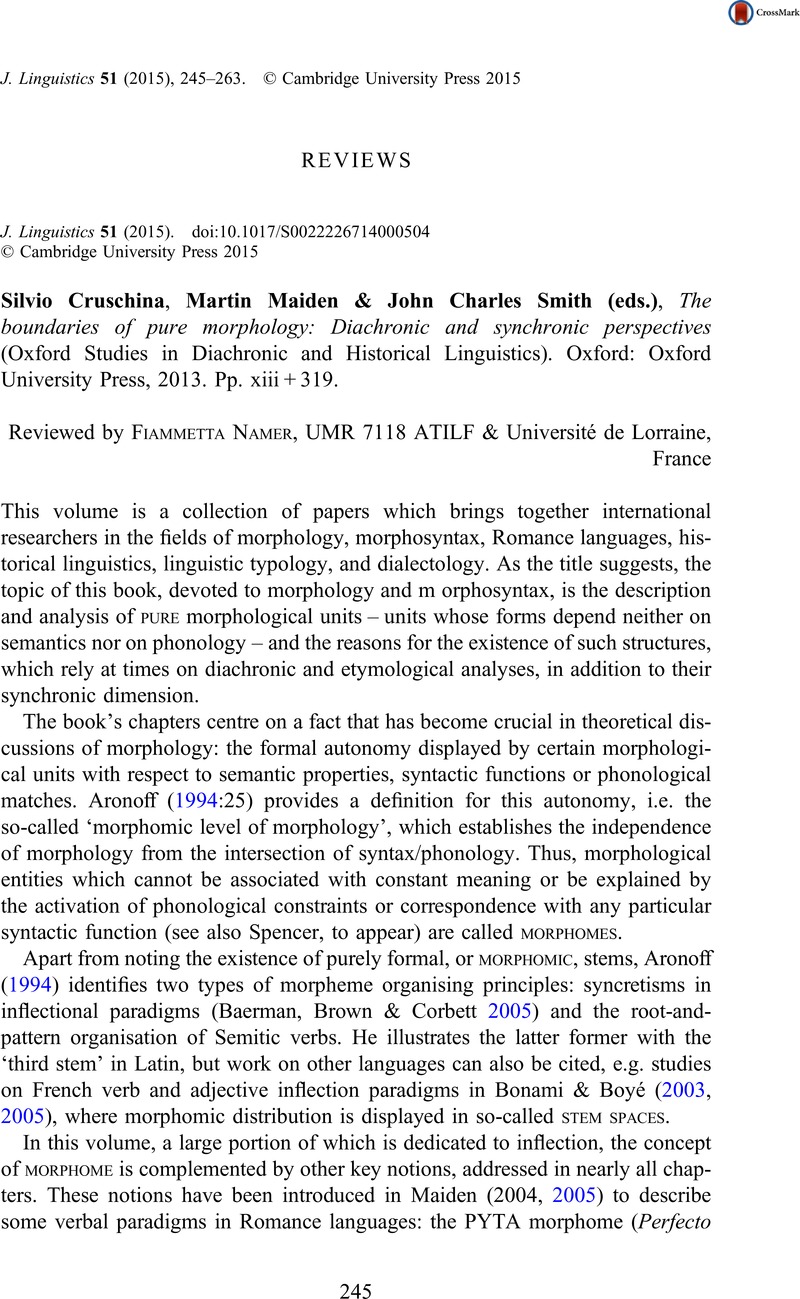No CrossRef data available.
Article contents
Cruschina Silvio, Martin Maiden & John Charles Smith (eds.), The boundaries of pure morphology: Diachronic and synchronic perspectives (Oxford Studies in Diachronic and Historical Linguistics). Oxford: Oxford University Press, 2013. Pp. xiii + 319.
Review products
Cruschina Silvio, Martin Maiden & John Charles Smith (eds.), The boundaries of pure morphology: Diachronic and synchronic perspectives (Oxford Studies in Diachronic and Historical Linguistics). Oxford: Oxford University Press, 2013. Pp. xiii + 319.
Published online by Cambridge University Press: 05 February 2015
Abstract
An abstract is not available for this content so a preview has been provided. Please use the Get access link above for information on how to access this content.

- Type
- Reviews
- Information
- Copyright
- Copyright © Cambridge University Press 2015
References
REFERENCES
Baerman, Matthew, Brown, Dunstan & Corbett, Greville G.. 2005. The syntax–morphology interface: A study of syncretism. Cambridge: Cambridge University Press.Google Scholar
Bonami, Olivier & Boyé, Gilles. 2003. Supplétion et classes flexionnelles. Langages 152, 103–126.Google Scholar
Bonami, Olivier & Boyé, Gilles. 2005. Construire le paradigme d'un adjectif. Recherches Linguistiques de Vincennes 34, 77–98.Google Scholar
Halle, Morris & Marantz, Alec. 1993. Distributed Morphology and the pieces of inflection. In Hale, Kenneth & Keyser, Samuel J. (eds.), The view from Building 20: Essays in linguistics in honor of Sylvain Bromberger, 111–176. Cambridge, MA: MIT Press.Google Scholar
Maiden, Martin. 2004. When lexemes become allomorphs: On the genesis of suppletion. Folia Linguistica 38/3–4, 227–256.Google Scholar
Maiden, Martin. 2005. Morphological autonomy and diachrony. In Booij, Geert & van Marle, Jaap (eds.), Yearbook of Morphology 2004, 137–175. Dordrecht: Kluwer.Google Scholar
Maiden, Martin. 2009. From pure phonology to pure morphology: The reshaping of the Romance verb. Recherches Linguistiques de Vincennes 38, 45–82.Google Scholar
Maiden, Martin. 2011. Morphomes and ‘stress-conditioned allomorphy’ in Romansh. In Maiden, et al. (eds.), 36–50.Google Scholar
Maiden, Martin, Smith, John Charles, Goldbach, Maria & Hinzelin, Marc-Olivier (eds.). 2011. Morphological autonomy: Perspectives from Romance inflectional morphology. Oxford: Oxford University Press.Google Scholar
Pirrelli, Vito & Battista, Marco. 2000. The paradigmatic dimension of stem allomorphy in Italian verb inflection. Rivista di Linguistica 12, 307–380.Google Scholar
Spencer, Andrew. To appear. Stems, the morphome, and meaning-bearing inflection. In Luís, Ana R. & Bermúdez-Otero, Ricardo (eds.), The morphome debate: Diagnosing and analysing morphomic patterns. Oxford: Oxford University Press.Google Scholar




